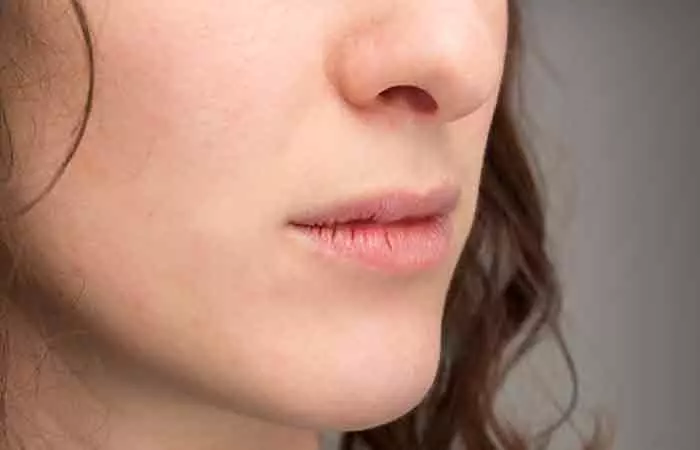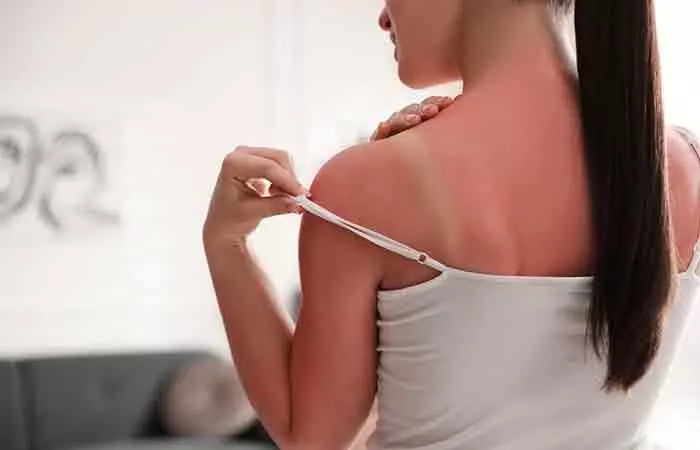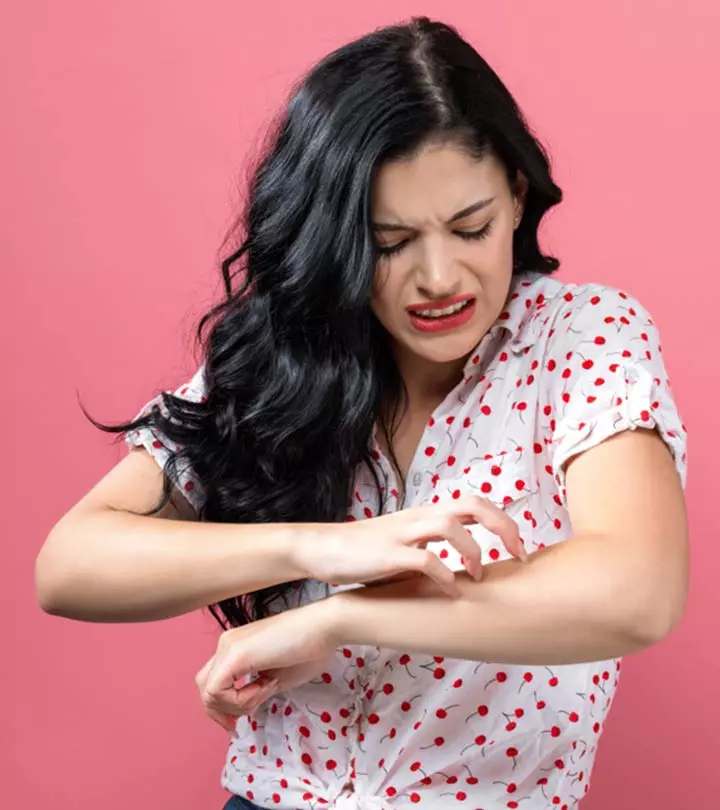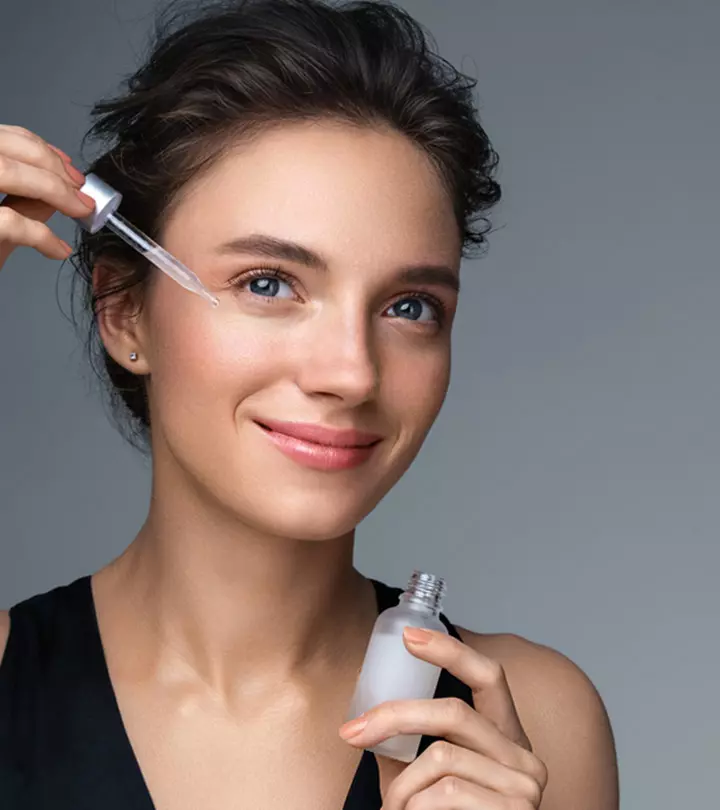Lanolin For Skin – Benefits, How To Use, & Side Effects
Ways to make the most of this emollient to get that soft and supple skin.

Image: Shutterstock
If you struggle with dry and flaky skin, especially during colder months, lanolin can be your skin’s best friend! There are multiple benefits of using lanolin for the skin. This waxy substance has excellent emollient properties and locks in moisture to keep the skin hydrated and soft. However, it may also cause allergic reactions (1).
Lanolin is especially beneficial in protecting the skin from harsh cold temperatures. However, if you are allergic to wool, you should avoid lanolin. Keep reading to understand how lanolin may benefit your skin, why it gained a bad rep, how to use it, and side effects.
 Know Your Ingredient: Lanolin
Know Your Ingredient: LanolinWhat Is It?
A waxy secretion from the sebaceous glands of sheep
What Are Its Benefits?
Lanolin is a moisturizing ingredient that moisturizes the skin, treats chapped lips, prevents cracked nipples, heals sunburns, and keeps cuticles and nails healthy.
Who Can Use It?
People experiencing dry and flaky skin and skin irritation.
How Often?
Once daily or whenever the skin feels dry.
Caution
People allergic to wool might be allergic to lanolin as well; hence, conduct a patch test before use.
In This Article
What Is Lanolin?
Lanolin is sheep sebum, and its primary function is to condition sheep wool. It is extracted through the centrifugation technique that separates the lanolin from debris and other chemicals.
Refined lanolin is then used in ointments, topical medicines, and skin care products. It is mainly used for its moisturizing effects. However, in ancient times, people used unrefined lanolin to treat many skin issues. This is because its molecular structure closely resembles that of human sebum.
 Trivia
TriviaLanolin is available in two different forms: lanolin and lanolin alcohol. The latter is used in ointments and skincare products. Lanolin is semi-occlusive, i.e., it forms a barrier that protects your skin and gets absorbed at the same time. Once it sinks deep into your skin, it can hold 400 times its original weight in water. Hence, it keeps your skin moisturized on the surface and from within. Therefore it is a great way to moisturize your skin. Now, the question is, if lanolin is so beneficial for the skin, why did it get such a bad rap?
Key Takeaways
- Lanolin (sheep sebum) is a waxy substance used to moisturize skin.
- It is known for its emollient properties and may help treat flaky, dry skin, chapped lips, sunburns, and cracked nipples.
- Lanolin is available in many forms like creams, ointments, and lotions. But make sure to use it the right way to reap its maximum benefits.
Why Is Lanolin Considered Bad For The Skin?
Everything was going well until the 1960s when people using lanolin products started reporting allergic reactions. This was mainly due to the pesticides that the livestock farmers used to disinfect the sheep. If lanolin is not purified and processed in the right way, traces of pesticides and chemicals remain in it, which then cause allergic reactions. That was when lanolin turned out to be the wolf in sheep’s skin!
Later, with technological advancements in farming practices, extracting pure lanolin was no longer impossible. Lanolin was then back again, ruling the beauty and skincare industries.
Unrefined lanolin may contain allergens, so it needs to be purified through multiple processes. Pure lanolin is a weak sensitizer (2). It often does not cause any allergic reactions. Pure lanolin offers a host of benefits for your skin. Scroll down to find out more.
Benefits Of Lanolin For The Skin
1. Moisturizes The Skin

Lanolin is widely used in skin medications to treat rough, dry, and scaly skin. It can also heal skin burns, rashes, and minor itches. This is because lanolin is an excellent emollient and reduces trans-epidermal water lossi Refers to the water loss through the top skin layer (epidermis) leading to dryness and dehydration (TEWL).
It softens your skin, relieves dryness and flakiness, keeps skin moisturized, and relieves symptoms of skin conditions like eczema and psoriasis (3), (4), (5). When you apply lanolin over your daily moisturizer, it forms a layer on your skin to trap water and enhance the product’s efficacy.
A study found that a topical lanolin cream containing olive oil could lower the risk of dermatitisi Skin inflammation, irritation, and redness caused by allergic reactions, environmental factors, and other skin conditions in infants (6).
2. Can Treat Chapped Lips

Unhappy with your lips because they look like scaly fish during the winters? Lanolin can help you out. Lanolin is a common ingredient in lip balms. It has a waxy texture that covers up your scaly lips and prevents further chapping (7). It also absorbs moisture from the air and helps rejuvenate the tissues in your lips.
3. Helps Prevent Cracked Nipples
Constant breastfeeding can cause chapped and cracked nipples. Lanolin is traditionally used to improve cracked and sore nipples during breastfeeding (8). However, avoid it if you are allergic to wool. Consult a doctor before using lanolin to avoid any harmful reactions.
4. May Heal Sunburns

Lanolin has moisturizing properties. It prevents moisture loss and keeps the skin hydrated to reduce the burning sensation, minimize peeling, and soothe sunburned skin.
5. Keeps Your Cuticles And Nails Healthy

Applying lanolin to your cuticles and nails keeps them soft and healthy. It also helps prevent brittle nails aka vitamin deficiency of nails (9).
6. May Improve Fine Lines And Wrinkles

The moisturizing properties of lanolin keep the skin hydrated and plump. This may help improve the appearance of fine lines and wrinkles.
Lanolin is useful not only in skincare but also hair care. It acts as a moisturizer for dry hair and scalps. Its protective qualities also make it a common ingredient in medical ointments, offering soothing relief for irritated skin.
 Did You Know?
Did You Know?Lanolin is especially beneficial in protecting the skin from harsh winter climates and dry indoor conditions. However, make sure you are using it in the right way. Here is a guide.
How To Use Lanolin
Lanolin is available in the form of creams, lotions, and ointments. Use it as directed by the manufacturer or consult a doctor. You may also follow these tips:
- Apply a pea-sized amount of the product to the affected area.
- Rub it gently and leave it overnight or as directed by the doctor.
If you are a nursing mother:
- Massage a pea-sized amount of the product onto the entire nipple area.
- Apply it after each feeding.
- You need not wash it off while breastfeeding (consult a doctor for this).
For soothing diaper rash or dermatitis in kids or infants:
- Clean the area well and let it dry thoroughly.
- Apply the product to the diaper area.
- Wait for a few minutes before you put on the diaper.
- Do this after each diaper change.
Note:
For best results, apply lanolin on damp skin (preferably after you shower). This helps seal in moisture for better hydration.
Before using lanolin, read all instructions on the product label and do a patch test before applying it. Lanolin may not suit all skin types and may cause some side effects. Let’s take a look.
Risks And Precautions
1. May Cause Allergic Reactions
Lanolin allergies are rare. However, it may still cause sensitization. A review of 24, 449 allergy-prone patients demonstrated that those with lower leg dermatitis and anogenital dermatitisi Refers to skin inflammation, itching, and redness on the skin around the anus and genitals were allergic to wool alcohols (lanolin) (10).
Lanolin may cause allergic reactions like:
- Rashes
- Shortness of breath
- Stinging sensation
- Swelling (lips and eyes)
- Sore throat
- Blisters and burning sensation (severe cases)
Sarah, a beauty blogger, holds a strong stance against lanolin. Her avoidance of lanolin stems from ethical concerns regarding its origin in the meat industry and her allergic reaction to both lanolin and wool. Sarah advocates for individual patch testing, stating, “Bottom line is lanolin is a known skin irritant for some people. You need to patch test as there is a chance you may experience an allergic reaction (i).”
2. May Cause Breakouts
If you are prone to breakouts, avoid using lanolin. It is mildly comedogenic and occlusive and can clog your skin pores. Avoid lanolin if you have oily, acne-prone, and sensitive skin.
3. May Cause Lanolin Poisoning
Ingesting lanolin may cause poisoning. There is always a risk of pesticide residue in lanolin (11). You may experience symptoms like vomiting, diarrhea, skin redness. Hence, be careful when using lip balms or lip products containing lanolin.
When buying products containing lanolin, ensure that the lanolin is non-GMO and pesticide-free. Always go for products that use organic lanolin. Acne-prone individuals and those with wool allergies should avoid lanolin. Scroll down to know lanolin alternatives for your skin.
Lanolin Alternatives
You may go for ingredients like:
- Mineral oil
- Paraffin
- Petroleum jelly
These ingredients form a barrier on the skin to prevent moisture loss. Also, they are hypoallergenic.
If you are looking for natural moisturizers, opt for:
- Beeswax or vegetable waxes
- Hydrogenated plant oils
- Shea or cocoa butters
Note:
Avoid beeswax if you are allergic to pollen.
Infographic: Top 6 Benefits Of Lanolin For The Skin
Lanolin, derived from wool’s natural oils, has long been prized for its intensely moisturizing and skin-protecting properties. It offers a wide range of benefits that include hydration, supporting the skin barrier, and nourishing the skin from the inside out. Check out the infographic below to learn more about the benefits of lanolin.

Illustration: StyleCraze Design Team
Hopefully, you are now clear on the question of ‘what is lanolin’ and that it is a multipurpose ingredient with excellent emollient properties, which helps lock in moisture and keeps your skin hydrated and soft. However, lanolin may cause allergic reactions and is unsuitable for oily and sensitive skin. So, if you have been using lanolin without any issues, you can continue using it. However, if you will be using it for the first time, do a patch test, and consult a doctor to determine if it is suitable for your skin. This will help you avoid unwanted side effects.
Frequently Asked Questions
Can I use lanolin on the face?
Yes, you can use lanolin on the face. However, it is best to avoid using it if you have oily, acne-prone, and sensitive skin as it may lead to acne breakouts.
Is lanolin better than Vaseline?
The high-fat content of lanolin makes it a better choice than Vaseline. Therefore, many prefer lanolin over Vaseline for lips.
Can Lanolin be used as a moisturizer or in conjunction with other skincare products?
Owing to its viscous nature, it can help seal moisture into your skin by acting as an occlusive. Using it at the end of your skincare routine can keep your skin soft and moisturized for long hours. You can also use it alongside a light moisturizer for extra nourishment.
Illustration: Lanolin For Skin - Benefits How To Use & Side Effects

Image: Stable Diffusion/StyleCraze Design Team
Unlock the wonders of pure lanolin for your skin with this video! Check it out to learn how to apply it to your skin for a nourishing and moisturizing experience.
Personal Experience: Source
StyleCraze's articles are interwoven with authentic personal narratives that provide depth and resonance to our content. Below are the sources of the personal accounts referenced in this article.
i. Why I do not use Lanolin
http://ww16.sugarpuffish.uk/2013/01/why-i-do-not-use-lanolin.html?m=1&sub1=20250210-2223-1336-9958-42c5bf2c00e0
References
Articles on StyleCraze are backed by verified information from peer-reviewed and academic research papers, reputed organizations, research institutions, and medical associations to ensure accuracy and relevance. Read our editorial policy to learn more.
- STUDIES OF SKIN-HYPERSENSITIVITY TO LANOLIN
https://www.jidonline.org/article/S0022-202X(15)48387-3/pdf - Paradoxes in dermatology
https://www.ncbi.nlm.nih.gov/books/NBK501842/ - Management of Patients with Atopic Dermatitis: The Role of Emollient Therapy
https://www.hindawi.com/journals/drp/2012/836931/ - Emollient treatment of atopic dermatitis: latest evidence and clinical considerations
https://www.ncbi.nlm.nih.gov/pmc/articles/PMC5908267/ - The Role of Moisturizers in Addressing Various Kinds of Dermatitis: A Review
https://www.ncbi.nlm.nih.gov/pmc/articles/PMC5849435/ - The effect of daily treatment with an olive oil/lanolin emollient on skin integrity in preterm infants: a randomized controlled trial
https://pubmed.ncbi.nlm.nih.gov/18429773/ - Efficacy of HPA Lanolin® in treatment of lip alterations related to chemotherapy
https://www.ncbi.nlm.nih.gov/pmc/articles/PMC3881864/ - Lanolin
https://www.ncbi.nlm.nih.gov/books/NBK501842/ - Pathogenesis, Clinical Signs and Treatment Recommendations in Brittle Nails: A Review
https://www.ncbi.nlm.nih.gov/pmc/articles/PMC6994568/ - A retrospective analysis of contact allergy to lanolin
https://pubmed.ncbi.nlm.nih.gov/11453903/ - Lanolin
https://www3.epa.gov/pesticides/chem_search/cleared_reviews/csr_PC-031601_5-Mar-91_002.pdf
Read full bio of Dr. Kendall R. Roehl
Read full bio of Ramona Sinha
Read full bio of Eshna Das
Read full bio of Shiboli Chakraborti



























Community Experiences
Join the conversation and become a part of our empowering community! Share your stories, experiences, and insights to connect with other beauty, lifestyle, and health enthusiasts.